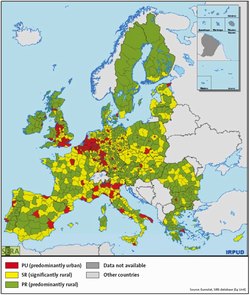Definitions of rurality vary between countries, reflecting different national experiences, environments, and administrative structures. In a European context, however, the OECD approach has been widely adopted as a basis for the socio-economic analysis of rural policies.
 Communities with a population density below 150 inhabitants per square kilometre are classified as rural. This classification is not however very appropriate in the Nordic context, because it is based on NUTS3 regions. This scale of analysis implies that there are no predominantly urban regions in either Sweden or Finland. According to this classification almost 90% of the population in the four Nordic countries live in rural NUTS3 regions covering 95% of the area.
Communities with a population density below 150 inhabitants per square kilometre are classified as rural. This classification is not however very appropriate in the Nordic context, because it is based on NUTS3 regions. This scale of analysis implies that there are no predominantly urban regions in either Sweden or Finland. According to this classification almost 90% of the population in the four Nordic countries live in rural NUTS3 regions covering 95% of the area.
In this light Nordregio has developed a classification system that is far better suited to the Nordic context. It operates with two classes ‘rural’ and ‘mixed’. Population density below or above 150 inhabitants per square kilometre is again used as the main measurement criterion but this is supplemented with an additional measure of whether the largest town in the area is below or above 25 000 inhabitants.
The result of this exercise is that the total population of ‘rural’ municipalities falls to 6.6 millions or 27% of the total population in the five Nordic countries. Another result of this definition is that Finland and Norway have more than 40% of their population in ‘rural’ municipalities, while Sweden has just 24% and Denmark only 3.5% in such areas.
The map shows the OECD classification in a 2006 version used Europe-wide and identifying three classes of regions:
• Predominantly urban < 15% population in rural communities
• Significantly rural, 15 – 45% population in rural communities
• Predominantly rural > 50% population in rural communities